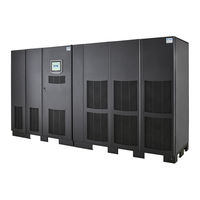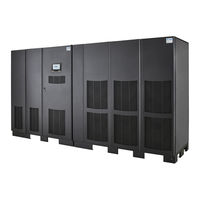Eaton Powerware Plus 1 Manuals
Manuals and User Guides for Eaton Powerware Plus 1. We have 5 Eaton Powerware Plus 1 manuals available for free PDF download: Installation And Operation Manual
Eaton Powerware Plus 1 Installation And Operation Manual (250 pages)
450–825 kVA
Brand: Eaton
|
Category: Power Supply
|
Size: 15 MB
Table of Contents
-
-
-
-
-
-
Initial Startup101
-
-
-
Single UPS126
-
Modes126
-
Online Mode126
-
Bypass Mode129
-
Battery Mode131
-
-
-
-
-
System Events165
-
Using the Menu167
-
-
-
Charger Control203
-
Advertisement
Eaton Powerware Plus 1 Installation And Operation Manual (256 pages)
450–825 kVA Powerware Series
Table of Contents
-
-
-
-
Sync Control17
-
Getting Help23
-
-
-
-
Initial Startup111
-
-
-
Single UPS136
-
Online Mode137
-
Bypass Mode139
-
Battery Mode140
-
-
-
-
Control Panel182
-
Circuit Breakers182
-
-
-
System Events184
-
Using the Menu186
-
MIMIC Screen186
-
Load off Screen190
-
-
-
Eaton Powerware Plus 1 Installation And Operation Manual (190 pages)
450–550 kVA
Table of Contents
-
-
Warranty9
-
-
Sync Control13
-
Getting Help18
-
-
-
-
-
-
Single UPS96
-
Modes96
-
Normal Mode96
-
Bypass Mode98
-
Battery Mode99
-
-
-
-
-
-
-
System Events127
-
MIMIC Screen129
-
Using the Menu129
-
Load off Screen134
-
-
Charger Control146
-
-
Charger Control166
Advertisement
Eaton Powerware Plus 1 Installation And Operation Manual (192 pages)
Powerware
Table of Contents
-
-
Warranty11
-
Getting Help18
-
-
-
-
-
-
Operation111
-
-
-
Single UPS114
-
-
-
-
-
Control Panel144
-
-
Circuit Breaker144
-
System Events145
-
Using the Menu147
-
MIMIC Screen147
-
Load off Screen152
-
-
-
Charger Control158
-
-
Charger Control167
Eaton Powerware Plus 1 Installation And Operation Manual (144 pages)
650–825 kVA
Table of Contents
-
-
Warranty9
-
Getting Help15
-
-
-
-
-
Modes94
-
-
-
Circuit Breaker106
-
-
-
System Events107
-
MIMIC Screen109
-
Using the Menu109
-
Load off Screen114
-
Operation114
-
Charger Control119
-




